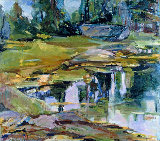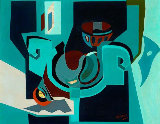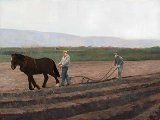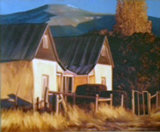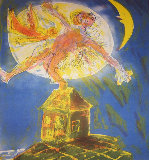





Parade Watercolor 1934 24x28 - Key West, Florida
Adrian Dornbush
Original Painting : Watercolor
Size : 14.5x19 in | 37x48 cm
Framed : 23.5x27.5 in | 60x70 cm
Reduced
-
🔥🔥🔥🔥🔥FABULOUS 1934 Framed Watercolor - Inquire - A SUPER Steal $$$$$$$
WPA Artist
Year1934
Hand SignedLower Left
Condition Excellent
Framed with GlassBrown Wood Frame w/ White Mat
Purchased fromOther 1993
Certificate of AuthenticityArt Brokerage
Additional InformationBE SURPRISED - SUPER SUPER
LID163107
Adrian Dornbush - United States
Art Brokerage: Adrian Dornbush Dutch American Artist: b. 1900-1970. Adrian Dornbush was born in Holland. Dornbush pursued his education at the University of Wisconsin (BA, 1918), the University College of Liberal Arts, Wisconsin (1922, 1924), the University of Kansas (1928-29), and two years of overseas studies. Following his first solo exhibition at the Des Moines Public Library in 1925, he became an art teacher in the Dubuque, Iowa public school district from 1926-28. After being elected president of the Dubuque Art Association, he organized the Flint Institute of Art in Flint, Michigan. Later, after resigning himself to the full-time life of a painter, Dornbush lectured at the Little Gallery in Cedar Rapids, Iowa, where he became friends with Edward Rowan, organizer of the Stone City Art Colony. Dornbush was named director and a charter faculty member of the Anamosa art colony in 1932-33. Following the colony's closing, he relocated to Des Moines and taught at the Art Students Workshop while handling a number of portrait commissions, most in watercolor. He exhibited at the Chicago World's Fair, the Iowa Art Salon, and won numerous prizes from the Iowa Artist Club and the Iowa Federation of Women's Clubs. Through his connection to Edward Rowan, Dornbush became involved in the new Key West, Florida FERA (Federal Emergency Relief Administration) art experiment and moved to the area for eight months in 1934. He became the director/coordinator of the project and focused his efforts on developing regional tourism and national recognition of local artists. The Key West program was deemed a tremendous success and is seen as the precursor to the national WPA art program that began in 1935. Dornbush was then appointed to run the "Special Skills" branch of the WPA's Resettlement Division that same year, a program designed to employ artists in folk crafts, furniture design, and other native arts. As a Washington-based coordinator, Dornbush supervised all federal artwork programs in the Tennessee Valley area. He worked directly under Rowan, who had been recently appointed as associate director of the WPA, a division of the U.S. Treasury department. He remained with the division from 1939-1942 until World War II caused the federal government to abandon arts funding to focus on the war effort. Dornbush instituted National Art Week in 1940-42 and left Washington to become assistant director of the Resettlement Division, USDA Special Service Section, composed of artists and designers. He eventually moved to Puerto Rico, where he died in 1970. Listings wanted by Art Brokerage.



















